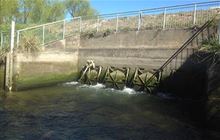Fish passage management
Introduction
Our waterways need to be carefully managed so native fish can access the habitats they need. These fish move within rivers and streams and to and from the sea to complete their lifecycles.New Zealand has more than 50 species of native freshwater fish and several sports fish. Many of these species, like whitebait and eels, need to move between freshwater and the sea to complete their lifecycles. Some also move upstream and downstream between different habitats in rivers and streams.
About 70% of our native fish are threatened or at risk. If their movement up and downstream is delayed or blocked completely, fish may not be able to get to the habitats they need to complete their lifecycle. Their numbers can be reduced, or they may be completely lost from a stream.
Fish passage connects all the habitats that are necessary for freshwater fish and other instream organisms like frogs, shrimps and aquatic invertebrates, to complete their lifecycles. Ensuring fish can move within, over and through physical structures, as well as managing the water quality and flow conditions in a waterway that may impede passage, are essential for fish passage management.
Barriers to fish passage
Culverts, weirs, fords, dams and tide and flood gates are common in streams and rivers throughout New Zealand. If they are not designed, maintained and installed correctly, these instream structures can stop fish moving up and downstream and to the sea.
Disconnections between the water upstream and downstream of a structure can stop or slow down fish passage. This can be caused by culverts with a significant drop at the downstream end, extremely long structures, perched (undercut) structures, fast water flow through a structure and weirs that are too high for fish to navigate. Fish can also be sucked into water intakes if they don’t have suitable fish screens or are not designed to keep fish in the waterway.
Some fish species are more affected by instream structures than others. For example, inanga are weak swimmers, whereas kōaro whitebait and baby eels can climb wet surfaces very effectively.
- Watch videos to see how different freshwater fish swim.
Bridges across a stream provide the best fish passage because they preserve the natural stream bed and banks and don’t change the water flow. If a bridge is not possible, instream structures can almost always be built or modified to allow for fish passage.
Providing fish passage is good for most fish, but removing barriers can have an impact by introducing invasive species to a new area. Some important locations need barriers to help protect native species and ecosystems by keeping invasive fish out.
How to manage fish passage
- Identify and record barriers: use the fish passage assessment tool to identify, assess and record existing instream structures. Fish passage assessment tool (FPAT).
- Once a barrier has been identified, determine which species are or could be using the pathway, then decide whether it is best to:
- fix barriers that are likely to be preventing fish passage
- retain barriers that are protecting native fish and biodiversity in certain locations.
- Design and build new structures to provide appropriate fish passage.
- Obtain appropriate approvals if you’re fixing a structure or building a new one, and think about whether monitoring will be required.
- Use available resources and tell people about our amazing fish and their fish passage needs. Get involved and support initiatives like World Fish Migration Day



